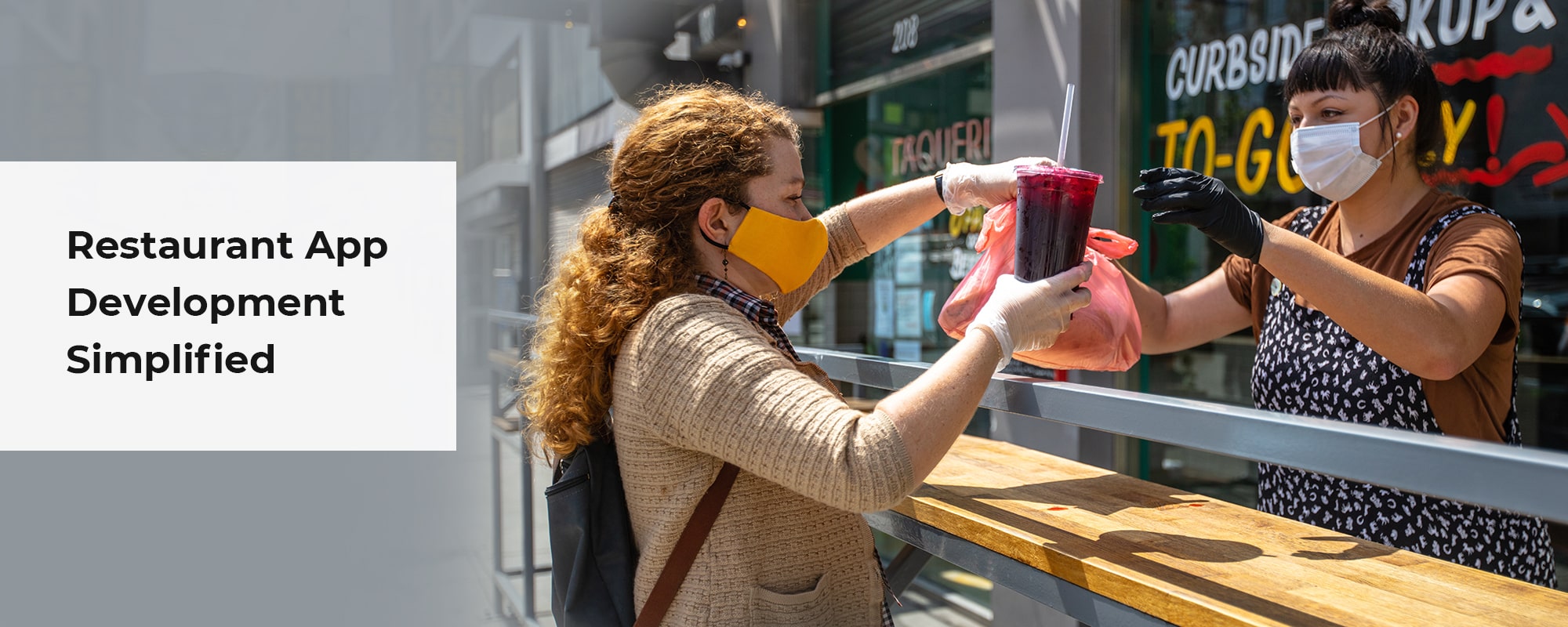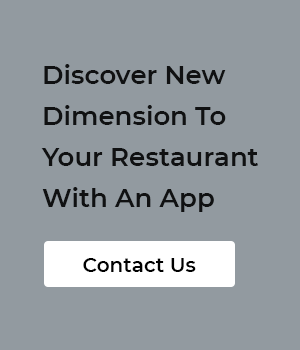Last Updated: 27th February , 2023
The restaurant value chain has seen a steep rise in the recent past. With digitalization reigning across industries, the restaurants have been among quick responders to the transformation. The restaurants tried their best to keep services running throughout the pandemic.
When everything shut down and everybody was forced to stay confined, restaurants continued food delivery to those who needed it most. Students and youngsters staying alone without any kitchens of their own relied on online food delivery and the industry suddenly rose to the occasion.
How imperative a mobile application would be to match market demands is crystal clear. Not restricting ordering food to devices, but extending its expanse to portable and mobile gadgets will provide seamless expansion of the scope with which restaurants are able to cater to consumers online.
Understanding the dilemma a business enthusiast faces, of having to take decisions on multiple fronts, we help through this blog to systematically discuss the steps that will help guide in restaurant app development process.
Table of Contents
Trends in Restaurant App Development
With the advent of the digital within the restaurant industry, every restaurant has picked up the pace to match the changing scenarios. Be it augmenting the interface for consumers, relationship with facilitators for delivery and procurement, or better interacting software with third party APIs, every step taken added convenience and embraced technology.
If we look at the patterns and statistics we observe:
- The market for online food delivery is about to reach $29,000 million.
- The most significant segment involving delivery of food from restaurants alone is about to reach $17,000 million within 2021.
- With almost 85% of independent adults now using smartphones to find restaurants, close to 36% preferring to make table reservations via restaurant apps, and more than 25% now wanting to order as well as pay from the table through an app itself, the need for a restaurant mobile application is increasing.
- More than 80% of the restaurant owners feel that reaching consumers through channels that appeal better to them helps improve brand recognition and sales, so an app will help achieve all.
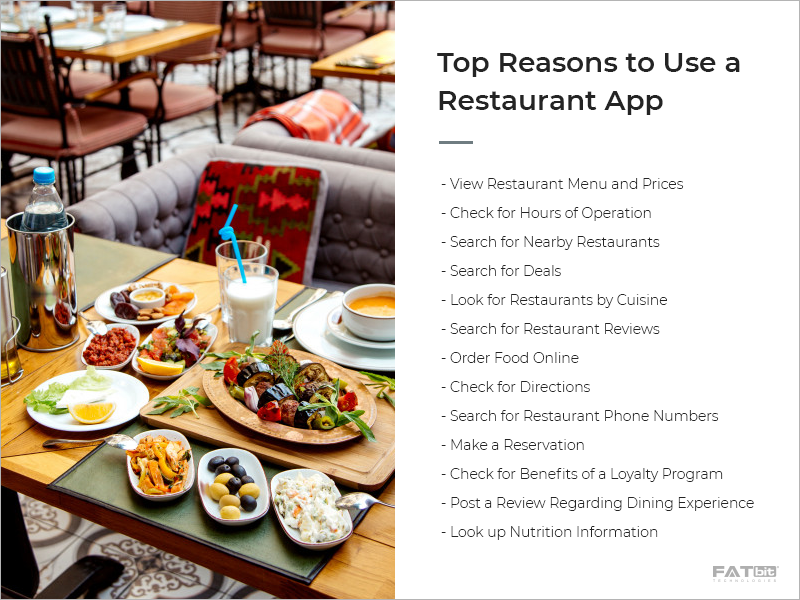
When entering a business in the online food delivery category, the best way forward is to understand the trends that mobilize the industry. Awareness into how an app adds to the popularity convinces owners to develop a mobile app for their restaurants.
Some noteworthy facts that add to the argument are:
- Adding digital channels for ordering and subsequently upgrading to delivery, the share prices of Dominos have risen by 40% since 2012. Today, it is reportedly getting 60% of all its orders through these channels. It also claims to have seen a significant rise in same-store sales within a quarter, due to addition of channels like online ordering and introducing a dedicated app.
- Starbucks has been able to add specific personalization features for its customers through the mobile app. Extending exclusive loyalty programs, deals and offers, it has exemplified user experience, and has been able to capitalize on the investments made on technical feature enhancements.
The transformation within the food value-chain has gained momentum with technologies like big data and artificial intelligence coming into main sight. A customized food or restaurant app development will exploit technology even more exhaustively.
Cloud, blockchain, AI, big data, and 5G services will all contribute to better customer understanding, experience, service, and safety in the online food delivery.
Benefits of Creating a Restaurant App
Every business mind understands the language of RoI, the return on investment made. Developing a restaurant app that helps fulfill a major purpose of seamless access demands a decent investment, and the benefits drawn from this development can contribute to growth of the restaurant business.
Creating a restaurant app can prove beneficial to both, a new restaurant business owner who is yet to launch into the market, as well as those who are already running their restaurant(s) and are looking to add to their marketing and expansion efforts.
Here we discuss for you some most prominent benefits that promote the idea of developing an adept app for your restaurant.
1. Brand Value Addition
A mobile application that allows consumers to access and locate nearby restaurants from any place, order their favorite food without being restricted to a device is a definite value addition to the brand.
Convenient connectivity goes a long way in creating impressions in the consumer minds.
2. Better Customer Experience
A well designed application that transitions smoothly from locating restaurants, making food item selections, ordering dishes, quick payments, to tracking orders till they are delivered, adds appeal and builds a refined experience for the end user.
All features integrated via well written APIs that help the application run uninterrupted for all operations enhances the UX.
3. Improved Payment Processing
The most critical of the steps for a business owner, while a user orders food online is the payment being made through the interface. An application with integrated third party payment modules allows this process from anywhere.
A minimum internet bandwidth by the mobile service providers makes the entire online food ordering more complete than ever.
4. Better Response to Bookings
When there is a feasibility to book a table for a suitable slot, the consumer feels free to finish other chores before they settle for their meal at their favorite restaurant. A restaurant mobile application providing this convenience invites more users to use the facility at hand.
The application can facilitate the user or restaurant owner to assign seatings visible to all, and the practice can add to ease of serving.
5. Loyalty Benefits
Loyalty programs over specific restaurant apps not only allow retaining old customers but attracting new ones too. A new consumer will choose to download a particular restaurant app if it is offering more deals compared to other restaurants.
Push notifications on latest deals keep the customer hooked to the app for making more transactions on the app.
6. Transparent Feedback
A restaurant app mostly always displays the feedback received on their dishes or service. This creates a reliable environment for customers as they know the positives as well as the negatives.
Also, feedback serves like a guidance to the restaurant owners to modify or improve what their customers desire.
Both new as well as existing business owners can derive benefits by choosing to develop or add a restaurant app. It is just considering what all functionalities to include through specific API integrations that can add real value to the online food ordering and delivering experience.
With an app, reaching a larger audience in the same vicinity becomes possible without having to spend time reaching people outbound, or attending phone calls limiting your capacity.
Identify Unique Benefits for Your Business with a Restaurant Mobile App
Types of Restaurant Apps
Once decided to add an app to your online food business platform, the next step is to understand what type of an app needs to be developed. Although, as users we feel all apps do the same thing, but each application is discreetly designed according to the online food business model.
Here are the most popular running apps supporting majority of the online food businesses:
Find Your Restaurant App
If the offering of an online business is to merely locate nearby restaurants within certain geo parameters, then a restaurant locator app is what is to be developed. The app allows users to find restaurants according to their choice of cuisines, food item, area of dining or ordering, and popularity.
This kind of an app development will need a comprehensive database of all the restaurants, cafes, and diners in different localities and neighborhoods. The database can be compiled using the Google Places API, and then geo location can be integrated to help users locate eating joints within their radius.
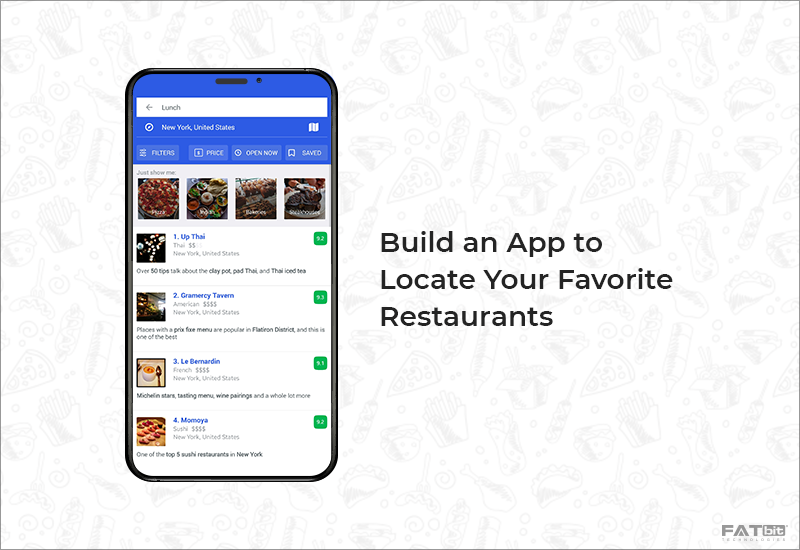
Important Features
- User profile
- Restaurant search or filters
- Restaurant listing & map views
- Restaurant information/menu customization screens
- Ingredients selection
- Photo gallery
- Photo/video upload
- Review & ratings
- Push notifications
- Activity stream
- Restaurant button/link
- In-app messaging/calling
On-table Order and Pay App
The on-table order and pay app facilitates an automated system for ordering and payment functionalities from the restaurant table without any personal interaction with the restaurant staff. In times when human-to-human interaction is reduced to a minimum in actuality, technology pledges to bring them closer.
The app includes a feature to place an order from the menu available, which creates a check for an order which is picked up by a kitchen display system (KDS). This order can then be completed through a payment and tip POS created, which can be closed on fulfillment of the function by the customer.
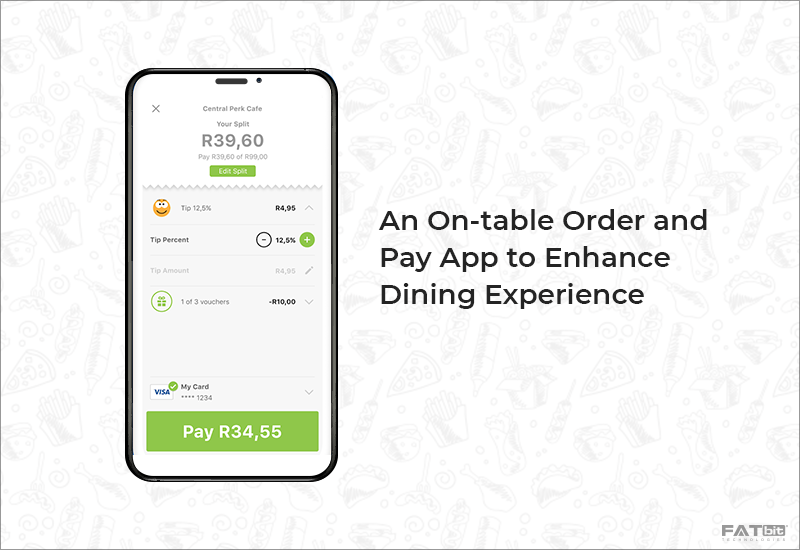
Important Features
- Menu
- Order form & details
- Reordering
- Order Ahead
- Loyalty programs
- Bill split
- Paying at the table/counter
- Mobile wallet integration
- Automatic tipping & tip addition
- Email/ print receipts
Online Ordering and Delivery App
For meeting requests pertaining to online food ordering and delivering, this kind of an app developed with end-to-end operational features provides complete business support. The app allows users to find restaurants in their vicinity, access menus, place orders, pay for the items selected, and track order delivery.
These can further be of two types:
- Full service application – These applications are developed without any support or feature added from the outside. Here the developers code for all features and the entire operation is independent of any third-party API.
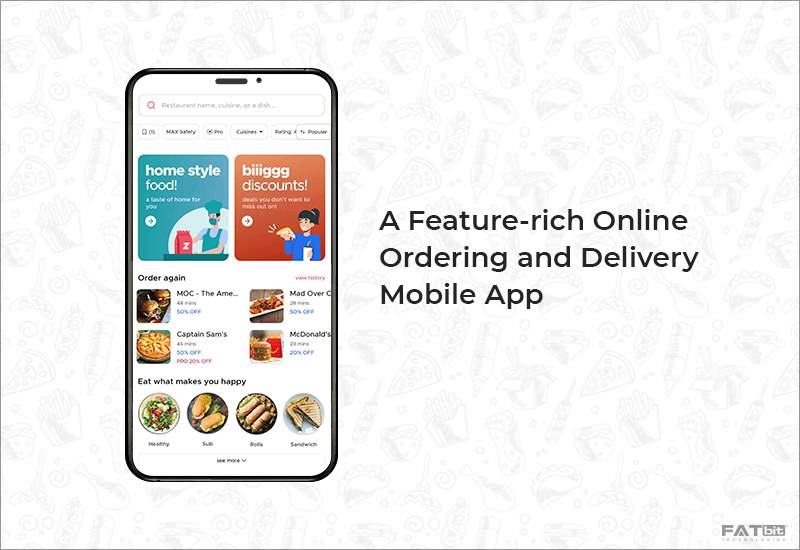
- Delivery aggregator or delivery service apps – These apps offer flexibility to restaurant owners to connect to a dedicated delivery service provider to deliver orders from their favorite restaurants to the customer’s locations. The Zomato app is a classic example.
Various third party integrations like order tracking, push notifications, feedback or reviews, help improve the restaurant’s services in coordination with the delivery team, towards a more efficient food delivery.
Important Features
- User profile
- Restaurant search & listings
- Menu
- Card registration
- Automatic payment
- Order details/history
- Order booking
- Delivery status
- Notifications
- Ratings
- Real-time chat
Loyalty Program App
An application that is developed primarily for the purpose of sharing details of ongoing and upcoming restaurant or food deals, is a loyalty program app. The restaurants develop this app independently for timely push notifications, alerts, and reminders to customers.
The app helps restaurants track how many old and how many new customers come on-board due to the offers or campaigns run from the restaurant. They can further plan their activities based on the user response.
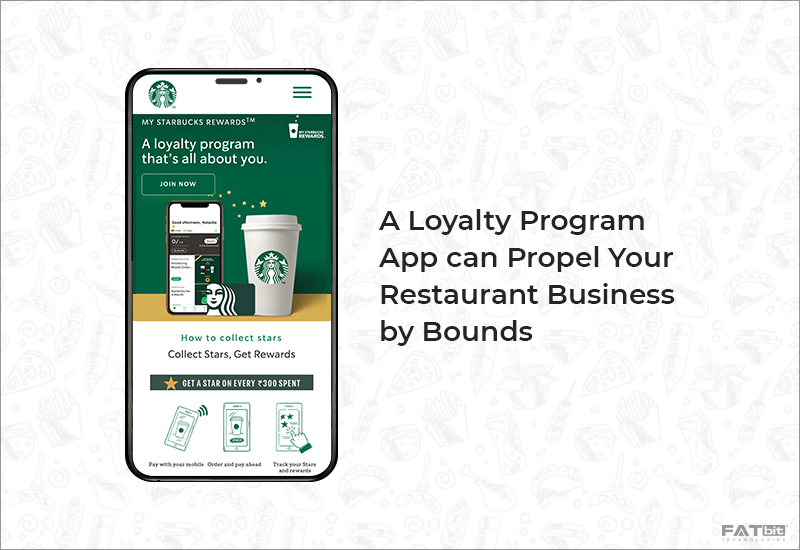
Important Features
- Offering rewards such as discounts, gifts & complimentary beverages
- Incentivized last minute bookings on the app
- Offer updations on a periodic basis
- Setting conditions for user rewards on the backend
- Free Stuff appetite such as free drink & other goodies
- Rewards scheme on user birthday
- Free-in-store refills through notifications
- In-app menu
- Mobile order & payment in advance
- In-app survey messages for star awards
- Music playing at any outlet to their own playlist within the app
The main decision is to decipher the need and type of application to develop. As the owner decides to move ahead with a particular type of app development, they are often caught in a circle of thoughts, as to where and how to begin and proceed with the vision.
To help you move past such thoughts, this section ahead will help with the basic approach and act as a guide for the restaurant app development.
Steps to Follow in Restaurant App Development Process
When determined to launch an app for any food business, the first challenge is to develop with the desired features and functionalities. Proceeding with a development partner is a wise option, but keeping note of a few criteria before beginning the process might just help save time as well as energy.
- Note that the developed restaurant app is solving a crucial challenge being faced by the restaurant ecosystem or industry.
- The development must be efficient in terms of time and money invested.
- The application must be simple to run as well as use so as to serve the purpose of adding convenience.
- Being an interface between different stakeholders, the restaurant app must be able to provide uninterrupted connectivity to fulfill the online food ordering activities.
- Try following a good design reference while creating a restaurant app. Although new ideas can change many things, taking a reference in the beginning might help clarify thoughts as the business progresses.
There are numerous ways to reach a destination, but it is always wise to follow a well-guided path as it might help prevent major pitfalls. The following points have been summarized in order to provide an overview of the process for the development of a strong application for any of the restaurant businesses.
What and How Much to Develop
The business owner or enthusiast must be clear on the business model for which the app needs to be developed. Majority of design and development will vary depending on the purpose the app needs to serve.
As, the loyalty program app will not need any integrations pertaining to tracking orders or delivery, and similarly the online ordering and delivery app will need additional third party integrations for online payments, GPS integration for order tracking, including APIs for accounts and finances.
Having identified the features desired, the investment must be made accordingly so as to get an efficient and justified outcome.
Market & Business Research
Now that the scope of the application to be developed is finalized, the next step should be to start with gaining a thorough understanding of the market. A sound food business is a result of an in-depth understanding of the market demands.
The app must be directed towards meeting the demand and supply. Information regarding:
- Knowledge of competitor offerings through the restaurant apps. Number of expected app users from day one.
- The amount of user data that needs to be recorded, managed and stored for retrieval time and again, so as to understand the database and server support.
- About what kind of network support different applications need so as to design the architecture and infrastructure accordingly.
- Options of different APIs that can possibly help reduce development time and speed up the go-to-market
These pointers could contribute to developing restaurant apps that supplement the business with better performance and user experience.
The Objectives to be Achieved – Functionalities of the App
Next in line should be to define descriptively the functions that the particular restaurant app needs to perform. Knowing these will help decide:
- How much to code – what is original and what can be bought. Can a ready-made platform be a quick go-to-market step.
- How many third party dependencies – API integrations for geo tracking, payments, push notifications, online menus, ordering, bookings, and more.
- Server specifications – depending on the size of user-base being targeted.
- Database type and size – to store different data points like addresses, contact numbers, locations, order and restaurant information, including some statistical analysis.
- Sources of connectivity to be built – restaurant names, location-wise.
The restaurant app development can begin at this point, with an adept team of developers creating an interface for the restaurant business to operate on.
Speed up The Development Process Using APIs
Depending on the type of restaurant app to be developed, the developers can choose from a number of available APIs so as to speed up the development for a quick launch.
The options that can be considered include:
- Regarding Information on Restaurants: Foursquare or Zomato APIs allow drawing all restaurant related data.
- For Location Services: To add functionality for route navigation and recommendations, Google Maps and Places can be integrated. Selecting a particular area will also vary according to the operating system. For Android, Google’s Location API does the job, whereas for iOS, Core Location Framework will be needed.
- Regarding Reservations and POS System: Rest APIs enable adding the functionality where users can select the exact table for dining. Several APIs are available for integrating the POS, like, Deliveroo API, Omnivore, and Simplicity.
- Including Suggestions/Recommendations: APIs facilitating AI generated tips for recommendations can be integrated. An example is the Qloo API.
- Payment Gateway: A number of options are available depending on the operating systems and areas in which the application is to be used. Some examples include Android and Apple Pay APIs, or those by Braintree, Stripe, and PayPal.
- Track Delivery: the Shippo API allows an orderly delivery process along with their tracking
- APIs to Get Reviews and Feedback: These are integrated to allow users to be able to leave reviews and feedback on the restaurant app.
- To Launch a New Feature: LaunchDarkly enables app owners to integrate new features into their application without any additional tech support.
UI-UX of the App
As the back-end decisions are being made, the front-end has to be parallelly designed. When the entire success of any online restaurant business depends on the kind of user experience they transcend, UI-UX becomes imperative to be invested upon.
An easy and quick registration is the first step to an attractive UX. Ensuring data safety through either integrating secure sign-in APIs from AWS or creating a basic sign-in with data locked inside secure servers. Smart catalogs, a streamlined ordering and POS, swift delivery track, and push notifications integrated will all be done to build the UI-UX and uplift a restaurant apps appeal.
Test, Deploy & Launch the App
The back-end and front-end when coded and combined with the desired third party feature APIs now need to be tested before the actual user gets on it to order their food. The application is to be tested rigorously for the load it is expected to bear, usability, regression, devices on which it is expected to be downloaded, and various status reports must be ready for any improvements required.
With all testing done, status reports ready, the application is ready for deployment on the servers of choice. It can then be launched on all the play stores for downloading.
Begin Marketing the App – Choose Campaigns That Make it a Brand
As the developed restaurant app is available live on different play stores, the app owner must begin marketing the app. Since various apps need to attract an audience who ultimately chooses food through an online service, the marketing campaigns need to be designed to meet the user as per their expectations.
Endorsing restaurants and offering opening discounts with loyalty benefits could serve great benefits for the business in the long run. It is this time at launch when customers would look for reasons to download the app. Once downloaded, very few jump to different apps for their food ordering. Providing them constant perks will have them market the app ahead through word-of-mouth, contributing to branding of the restaurant app.
Feedback Analysis From the Restaurant App
An application used for ordering food will definitely invite critiques and feedback from those happy as well as upset. So an analysis of the feedback gathered will play a big role in improving the live application.
There are multiple tools that can be integrated to gather feedback specifically in order to understand the audience better. These tools are designed to engage the user in different ways so that they share their feedback. Tools like mopinion, feedbackify, and HubSpot that facilitate gathering customer reviews on the service being offered through the application.
App Support & Enhancements
A functional restaurant app can be made better as and how the audience preferences are better understood. There are in-app enhancements as well as guidance tools that provide support to the users while they are using the app.
A new user on-boarded is given initial directions on the flow through the app, along with some interactive bots that allow communication between the support personnel and the user in case there is a problem. Salesforce offers such tools that build an in-app support system within the restaurant app.
Completion of development of a restaurant app might take much longer than it seems. It is ideally supposed to continue as inputs should be made whenever upgradation is needed in terms of services, technology, as well as customer satisfaction. An application that will improvise to serve better will always attract a much larger user-base.
Further on, the features are the striking elements that end up serving the ultimate goal of a restaurant app. In the section below we list down the most specific features for different types of restaurant apps discussed in the sections above.
Get Professional Consultation and Mobile App for Your Restaurant Business
Factors to Consider During the Restaurant App Development
A guide to a restaurant app development would not be complete without mentioning the most critical factors that influence the successful development, deployment, and operations that the app performs.
Now it is important to understand that development of a restaurant app involves a significant amount of back-end efforts according to the user variants for the app. The development strategy, involving steps around the discovery phase and other modules of the restaurant app happen in accordance with the different users and stakeholders.
The architecture of the restaurant app being developed will thus vary depending on the complexity of the app, which will define how robust it will be.
These factors help the app or restaurant owner decide how extensive the app must be so as to meet the goals of developing the application. The following are to name the few of the influential ones.
Bandwidth and Load Testing
While developing the app, it is a must to acknowledge the fact that despite a huge user base that uses the application simultaneously, the IT of the app must be robust and all possible risks leading to an app crash must be kept in mind. The idea is to ensure that under all circumstances the app remains operational as well as the data for the app owner, restaurant owner, as well as the user is not lost.
To address these factors, the probable scalability, response time, and resource usage must be considered.
Budget & Future Planning
It is a common observation that when an owner starts developing a restaurant app, the initial requirements casually overshoot. Especially when the development team uses agile practices for the app development, they use the luxury and the requirements keep pouring in. But then the pocket is what is most affected.
A wise suggestion would be to stick to your basic designs and user stories. Even though some new input comes to mind, decide a plan to balance the existing and the new components so as to fit it within the budget decided. Draw an estimate on the ROI of each new addition or add request so as to develop an efficient application.
Competitor Profiling
This forms the core around which the app will be developed. A successfully running application will offer the best case study for consideration of what to include and what not to go about while your app is being built.
A thorough competitor profiling would provide an insight into the popular features and the feedback or reviews will help shed light on how to develop a better application.
These factors will definitely help the development team on board to quickly decide the quality they need to deliver and deploy.
Possible Challenges
With every software development come upfront challenges that might pose hindrances in the process. These generic roadblocks if presumed well in time can help glide through easily, giving a restaurant app that will make ordering food online a much fun experience.
Competitor Landscape
The market is saturated with food delivery apps. The restaurants are using diversified ways to attract customers. The apps are giving their users a more and more personalized experience. The challenge to provide an edge above the existing is one of the most intense one the entrepreneurs can expect at the moment.
The way through would probably be to research and create user journeys with attractive offerings that compel customers to download the restaurant app.
Technology Upgrades
The pace at which online food ordering transcended from telephonic ordering to mobile apps, it is very hard to say what trend will control the industry in the future. It is upgrading the existing infrastructure according to the new.
While developing a restaurant app, the development team must design the code so as to easily facilitate owners to integrate the latest API updates as well as code upgrades.
Monetary Considerations
Another challenge that restaurant owners and the restaurant app development team will most probably face is keeping the monetary investment under the planned limits. As the development process proceeds with an agile methodology, the team might overshoot the budget with inclusions that were initially unplanned.
The idea is to understand as to what feature or addition will matter the most initially. Only those requests must be included that promise a high ROI from the very beginning, or else the inclusion of those can be postponed for later.
Bypassing the challenges and developing a robust and reliable restaurant app demands a strong technology stack backing it. No development is thorough without well strategized use of technological inputs. Let us review some of the necessary areas of development that will play a role in defining the quality and performance of the restaurant app.
Technology Stack
When discussing the technology stack that goes behind developing a strong application, we foray from the basic language for coding to the servers needed for deployment of the application. A sound knowledge of the requirements help define what to use for what purpose.
The tech stack needs to be chosen based on each development phase, as depicted here:
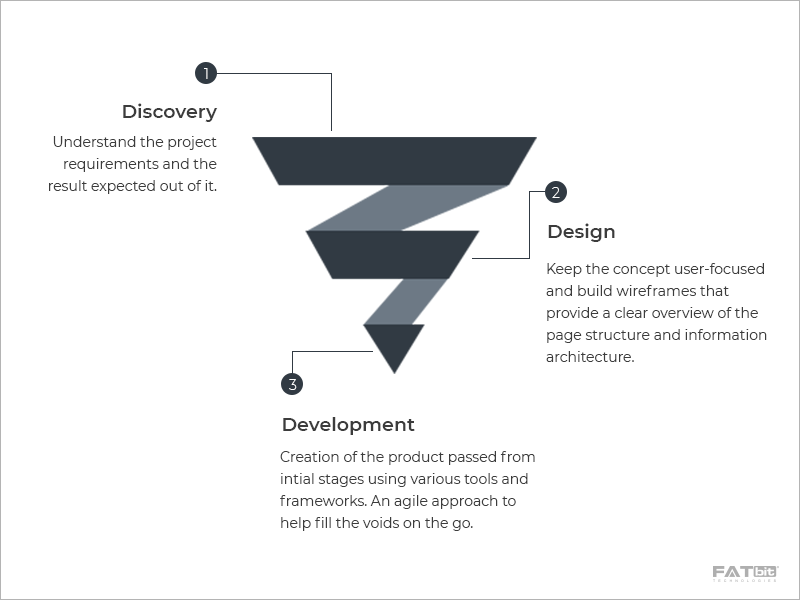
The first level should be to decide on what kind of application to develop, Native or Hybrid. This will help choose the SDK or the software development kit, which will be different for iOS and for Android deployment.
The toolkits and the languages will also vary for both iOS and Android. An overview of the technology stack needed to develop a basic functioning restaurant app is here under:
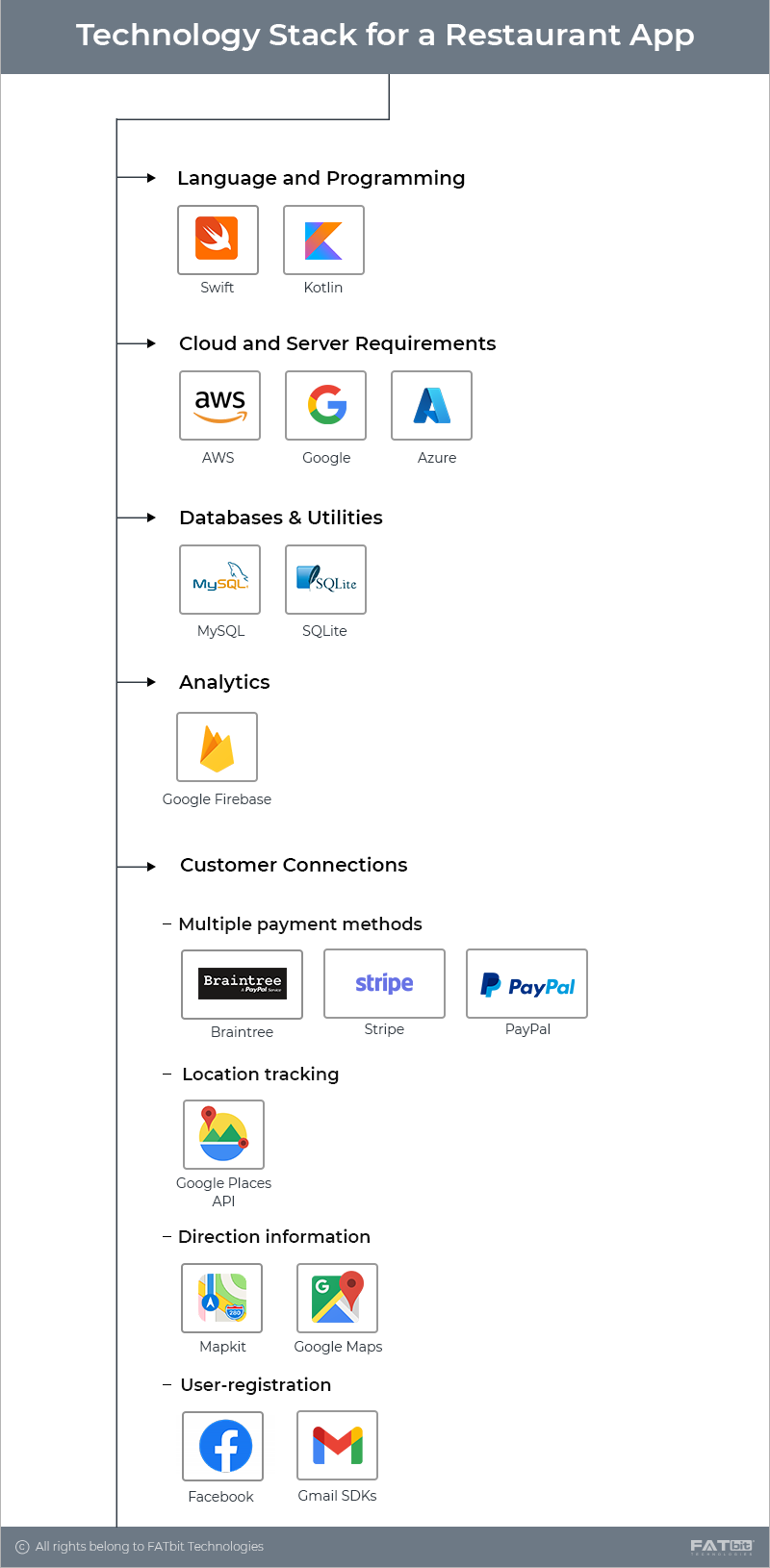
Language and Programming
Understanding whether your app will be a Native one or a hybrid one, the developers will code using Swift or Kotlin, that will help build powerful and proficient applications. The choice will also depend on the user base as well as the device on which the app is expected to be used majorly.
iOS as well as Android specific programming languages will reduce time to develop and the bugs that will come surface during testing or deployment. To develop an application that can run anywhere with enterprise-level performance, Java is a language of choice. The ease of development as well as higher business value can be derived through choosing the right language itself.
Cloud and Server Requirements
Selecting the server type for the developed restaurant application will depend on the expected user load. A cloud server like AWS, Google, Azure, or Digital Queen will provide continuous connectivity. If a local user-base is intended to be targeted, a local server will also suffice.
The development team needs to gather the app use requirements thoroughly to establish an appropriate server backup.
Databases & Utilities
Databases offer storage of all the data gathered over the application. Databases that allow easy storage, management, retrieval, migration, and access to data points contribute to good usage of the gathered data.
MySQL or SQLite databases offer ready APIs for easy integration and application with your developed software. Facilitating better managed data at the restaurant’s end will allow the owner to draw meaningful insights whenever desirable.
Analytics
A good analytics API integrated into the application will extract data from the database and give back meaningful insights. Google Firebase offer easily applicable APIs that provide quick and easy analytical outputs from the data at hand.
An analytical tool integrated with the developed restaurant application will help the owner take key business decisions. The analytics will help build good dashboards for the different users of the application, giving a clearer picture of the activity going over the interface.
Customer Connections
Building connections with the customers who come to order food over the application requires much thought. Many ways through which good connections can be built include:
- Multiple payment methods – Using Braintree, Stripe or PayPal integrations
- Location tracking – Using Google Places API
- Direction information – Using Mapkit and Google Maps
- In-app chat
- In-app guidance
- User-registration – Using Facebook and Gmail SDKs
- Feedback and reviews
When the customers are able to communicate through the application, they gain confidence over the system on which they order and pay. Third party integrations allow easy inclusion of these features, that will influence the convenience provided to the customer.
Development and Deployment
While all the inclusions and specifications are defined during the design phase, the development approach should be kept agile. This will add to the flexibility as well as satisfaction of the app owner.
An agile approach will allow an interactive process of value addition to the application being developed. A cross-functional team working towards building an application that delivers exceptional user experience adds to the competitive advantage. Facilitating a quick go-to-market favors business strategy and hence delivers an application that can be improved at every step.
Conclusion
A restaurant app development involves understanding the audience as well as the stakeholders who will directly interact and benefit from the app. Making ordering food online an experience worth enjoying is almost totally dependent on the kind of experience the application interface offers.
A thoughtful deciphering of the requirements between the development team and the restaurant owner can bring out an exceptional application which gains popularity due to its appeal and convenience.
A team proficient in custom mobile app development, which has delivered professional applications with all features desirable for a good and fully functional restaurant application is a must for a successful development objective to be achieved.
A restaurant app must be worth registering and revisiting, offering satisfaction just like the food it helps deliver.
